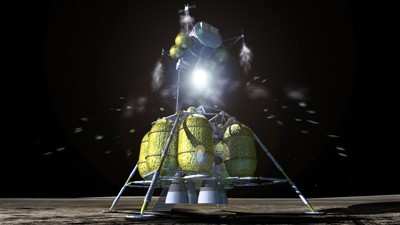Wed, Sep 03, 2008
Pratt & Whitney Rocketdyne Says Tests Will Help
Constellation Development
Engineers from NASA and Pratt & Whitney Rocketdyne
successfully completed a series of hot-fire altitude tests using
liquid methane on the RS-18 engine. The tests, conducted at White
Sands test facility in New Mexico, are part of the technology
development for NASA's Constellation program, and gathered
important data on ignition, performance measurement, and rapid
start and stop.

The RS-18 engine, which was last used to lift astronauts off the
moon's surface 36 years ago, was originally flown with storable
hypergolic propellants during the Apollo moon missions. It was
later modified to burn liquid oxygen and liquid methane, providing
increased safety and performance to future space vehicles.
"We're extremely proud to be part of this history-making
milestone," said Terry Lorier, RS-18 program manager, Pratt &
Whitney Rocketdyne. "It's tremendously gratifying to know our
engine technology is being tested for the NASA Constellation
Program. We literally pulled an engine off the museum shelf and
were the first to prove that liquid methane could be used on
hardware previously rated for storable propellants."
The cryogenic propellant-fueled RS-18 engine was modified under
NASA's Exploration Technology Development Program (ETDP), which
develops new technologies that will enable NASA to conduct future
human exploration missions while reducing mission risk and cost.
ETDP's Propulsion and Cryogenic Advanced Development Project, is
developing rocket engine and propulsion technologies for future
missions to the moon, Mars and beyond.
These propulsion systems would have higher performance than
current storable propellant systems and may have the potential to
use reactants mined from lunar and Martian environments.
The recent liquid methane tests on the RS-18 demonstrated
reliable ignition over a wide range of mixture ratios in vacuum
conditions; obtained performance data, chamber pressure data,
combustion efficiency and chemical kinetics effects, and combustion
stability data; demonstrated rapid engine start and shutdown; and
measured specific impulse.
More News
From 2023 (YouTube Version): Legacy of a Titan Robert (Bob) Anderson Hoover was a fighter pilot, test pilot, flight instructor, and air show superstar. More so, Bob Hoover was an i>[...]
Get The Latest in Aviation News NOW on Instagram Are you on Instagram yet? It's been around for a few years, quietly picking up traction mostly thanks to everybody's new obsession >[...]
Aero Linx: B-52H Stratofortress The B-52H Stratofortress is a long-range, heavy bomber that can perform a variety of missions. The bomber is capable of flying at high subsonic spee>[...]
Altimeter Setting The barometric pressure reading used to adjust a pressure altimeter for variations in existing atmospheric pressure or to the standard altimeter setting (29.92).>[...]
"Knowing that we play an active part in bettering people's lives is extremely rewarding. My team and I are very thankful for the opportunity to be here and to help in any way we ca>[...]
 Classic Aero-TV: Remembering Bob Hoover
Classic Aero-TV: Remembering Bob Hoover ANN FAQ: Follow Us On Instagram!
ANN FAQ: Follow Us On Instagram! ANN's Daily Aero-Linx (05.15.24)
ANN's Daily Aero-Linx (05.15.24) ANN's Daily Aero-Term (05.15.24):Altimeter Setting
ANN's Daily Aero-Term (05.15.24):Altimeter Setting Aero-News: Quote of the Day (05.16.24)
Aero-News: Quote of the Day (05.16.24)



